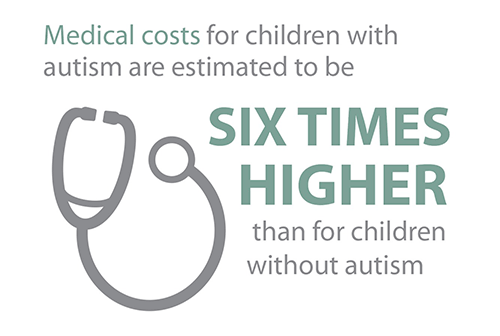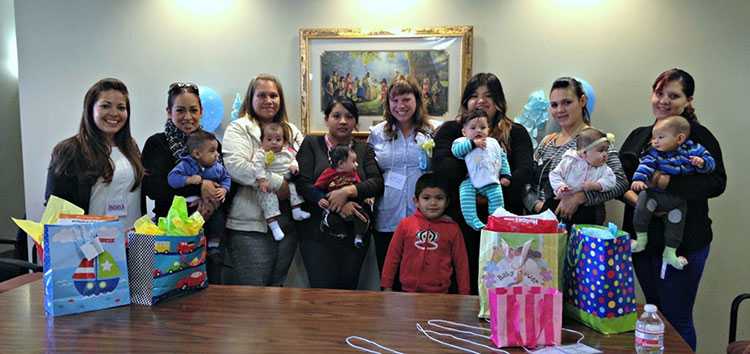Helping Children Live Life to the Fullest by Understanding Developmental Disabilities
 CDC’s National Center on Birth Defects and Developmental Disabilities (NCBDDD) is committed to learning more about developmental disabilities in order to help children and their families get the support they need.
CDC’s National Center on Birth Defects and Developmental Disabilities (NCBDDD) is committed to learning more about developmental disabilities in order to help children and their families get the support they need.

Developmental disabilities, such as attention-deficit/hyperactivity disorder (ADHD), autism, cerebral palsy, hearing loss, and vision impairment, are some of the most significant child health issues facing families and our nation today. About 1 in 6 children in the United States have developmental disabilities or other developmental delays.
NCBDDD is studying how common developmental disabilities are, identifying factors that can put children at risk, exploring possible causes, and improving identification of developmental delays so children and families can get the services and support they need as early as possible.
Budget and Funding
Accomplishments
- Published a new analysis from the Autism and Developmental Disabilities Monitoring (ADDM) Network on the prevalence and characteristics of autism spectrum disorder (ASD) among 8-year-old children. The investigation found that about 1 in 68 of these children were identified with ASD, based on tracking in 11 communities in the United States. An early ADDM study of 4-year-old children found that progress had been made in identifying children with ASD at younger ages. Information from ADDM can help promote early identification of children with ASD, plan for service needs of children with ASD and their families, guide research, and inform policy.
- Implemented the third phase of the Study to Explore Early Development (SEED). During the next 5 years, CDC will invest more than $27 million to carry out SEED 3. SEED is the largest study in the United States to help identify factors that may put children at risk for ASD. SEED 3 is enrolling 2,500 children at risk for ASD, which will increase total SEED enrollment to 7,500 children. CDC will also fund a site to conduct a brief follow-up study of children enrolled in the first phase of SEED, who will now be teenagers. The goal of this follow-up study is to better understand the long-term health and development of children identified as having autism at younger ages.
- Trained and supported 45 Act Early Ambassadors in 41 states and three territories. These ambassadors promote developmental monitoring and screening to help young children with developmental delays be identified and connected with appropriate services and support as early as possible. This collaboration with the ambassadors and other partners resulted in the integration of Learn the Signs. Act Early. materials into a number of programs that serve young children, such as pediatricians’ offices, Women, Infants, and Children (WIC) clinics, Head Start centers, and childcare and home visiting programs. These efforts resulted in a monthly average of more than 155,000 unique visitors to the Learn the Signs. Act Early. website, as well as 45,000 downloads of materials and more than 178,000 hard copy materials requested each month.
- Presented a CDC Vital Signs article to increase awareness and knowledge of behavior therapy as the recommended first-line treatment for young children with ADHD. The published Vital Signs article in Morbidity and Mortality Weekly Report, and supporting materials, such as the Finding a Therapist Fact Sheet, sparked more than 1,000 news articles. Related webinars also increased knowledge about effective behavior therapy for ADHD in young children among more than 2,300 clinicians and parents to date via collaborations with partners.
- Continued leading the national effort to collect quality data on babies and young children who are deaf and hard of hearing (D/HH). Quality data is defined as complete, timely, and accurate, and can help state and territorial programs ensure that all babies who are D/HH are identified early and receive intervention services that help them reach their full potential. NCBDDD supports efforts to standardize the accurate collection, analysis, and reporting of Early Hearing and Detection Intervention (EHDI) data ensuring it is comparable between states and territories. The latest data collected by CDC shows that more than 6,000 infants in the United States with a permanent hearing loss were identified early.

Looking to the Future
NCBDDD and its partners have been working for more than 15 years to track, research, and provide useful tools and information on developmental disabilities. Identifying developmental concerns at the earliest possible age offers children the best chance at early intervention and treatment. As we learn more about developmental disabilities, we ensure that children can live to their fullest potential. For ADHD, that means assuring that best practices are currently used for treatment. For ASD, it means giving communities the information that will best serve the needs of children and families. Through “Learn the Signs. Act Early” we will continue to develop high quality, effective tools to empower parents, health professionals, and communities to closely monitor development and act early on developmental concerns. For EHDI, we focus on helping states and territories have the data systems they need to ensure all deaf and hard of hearing children are identified early and can receive intervention services to help them reach their full potential.
Notable 2016 Scientific Publications
Bitsko RH, et al. Health-care, family, and community factors associated with mental, behavioral, and developmental disorders in early childhood – United States, 2011-2012. MMWR Morb Mortal Wkly Rep. 2016 Mar 11;65(9):221-6.
Christensen DL, et al. Prevalence and characteristics of autism spectrum disorder among children aged 8 years – Autism and Developmental Disabilities Monitoring Network, 11 sites, United States, 2012. MMWR Surveill Summ. 2016 Apr 1;65(No. SS-3):1-23.
Learn about NCBDDD’s Developmental Disabilities Topics
Christensen DL, et al. Prevalence and characteristics of autism spectrum disorder among 4-year-old children – Early Autism and Developmental Disabilities Monitoring Network. J Dev Behav Pediatr. 2016 Jan;37(1):1-8.
Di Guiseppi CG, et al. Demographic profile of families and children in the Study to Explore Early Development (SEED): Case-control study of autism spectrum disorder. Disabil Health J. 2016 Jul;9(6):544-51.
Leeb RT, Fluke JD. Child maltreatment surveillance: enumeration, monitoring, evaluation and insight. Health Promot Chronic Dis Prev Can. 2015 Oct-Nov;35(8-9):138-40.
Schieve LA, et al. Population impact of preterm birth and low birthweight on developmental disabilities in US children. Ann Epidemiol. 2016;26(4):267-74.
Van Naarden Braun K, et al. Birth prevalence of cerebral palsy: A population-based study. Pediatrics. 2016;137(1):e20152872.
Visser SN, et al. (2015). Demographic differences among a national sample of US youth with behavioral disorders. Clin Pediatr (Phila). 2016 Dec 23;55(14):1358-62.
Visser SN, et al. Vital signs: National and state-specific patterns of attention deficit/hyperactivity disorder treatment among insured children aged 2-5 years – United States, 2008-2014. MMWR Morb Mortal Wkly Rep. 2016 May 6;65(17):443-50.
Spotlight On: Oklahoma State University
This Spotlight was contributed by Jane Silovsky PhD, University of Oklahoma Health Sciences Center and Amanda Sheffield Morris, Ph.D., IMH-E IV®, Oklahoma State University
Legacy for Children™ (Legacy) is an evidence-based parenting program—supported by NCBDDD in its development—that focuses on promoting children’s health and socio-emotional development through strengthening the parent-child relationship, supporting maternal confidence in parenting, and improving mothers’ social support. It is a group-based program for mothers and their babies. The Tulsa community is implementing the Legacy UCLA curriculum, which begins prenatally and is offered through the first 3 years. In recognition of the need for culturally appropriate services, the Legacy program was translated and adapted for Spanish-speaking mothers and their infants. This program is being evaluated by University of Oklahoma Health Sciences Center and implemented through Oklahoma State University (OSU) in Tulsa.
Catholic Charities, one of the most respected resources in the Tulsa community for immigrant groups, helped OSU recruit Spanish-speaking mothers for the Legacy group. Furthermore, they provided a welcoming and comfortable space for the families to hold Legacy group sessions. The mothers in the Spanish groups were successfully engaged in the program. Initial findings from qualitative interviews suggest that mothers perceived the importance of both the social community that developed and the information that was gained.
Mothers in the Spanish Legacy groups particularly enjoyed the mother-only community-building session time (FUN Club). This mother-directed session component encourages mothers to socialize and build leadership and planning skills. The mothers were very creative during FUN Club, including coordinating a Zumba class and a facial tutorial from a make-up representative. They have also directly taught each other how to knit, make beaded bracelets, and other crafts. At the end of each FUN Club, Spanish groups have “convivios” which are very similar to a pot luck meal where the moms share homemade food with each other. Participants were all in agreement that they would recommend the Legacy program to Latino families, and it is a program OSU is particularly proud of.

Mothers in Oklahoma State University’s Legacy for Children™ Spanish program in Tulsa, OK.
- Page last reviewed: January 24, 2017
- Page last updated: January 24, 2017
- Content source:


 ShareCompartir
ShareCompartir

